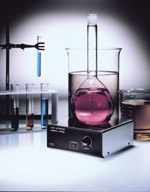

Magnetic Stirrers
 |
|
There are two types of magnetic stirrers producers. The first is the mechanical producer, and the second is the electronic one.
Most manufacturers of magnetic stirrers are using a mechanical approach. They use steel and aluminum for the structural material, and outdated methods of controlling the speed. These units are very heavy and very inaccurate. The use of these materials and methods appear to make the units rugged and strong. But they are instead cumbersome and outdated.
Something as simple as completely dissolving salts in a medium, is in reality, a Science. Often this cannot be achieved with simple mechanical processes. The only choice that the user has with mechanical products, is to increase the stirring time or the temperature.
With electronics, you can do more . . . the Hanna approach is electronic.
Safety: Electronic controls allow the stirrer to control the speed with greater accuracy. By using electronic devices, the speed of the motor can be governed not to exceed a pre-set RPM, with or without a load. This also has the added advantage that the motor can be running at the maximum operating speed with a load, and if the load is suddenly removed, the circuitry will not allow the motor to increase in speed which would damage the unit.
Common Sense: It is advantageous to stir in two directions to obtain homogeneous results. This cannot be done with a mechanical stirrer. To accomplish this, Hanna has incorporated motor drivers which reverse the direction at certain user-selected time intervals.
Accuracy: Adjusting the stirring speed with a mechanical stirrer is inaccurate. Similar to the "Zoom" function of a microscope, you can have access to two separate ranges by using electronics. This assures maximum repeatability in experiments and processing.
Flexibility: In the laboratory, everything is related to time. In order to control time, a timer must be used to regulate the stirring. With Hanna stirrers, once the selected time has been reached, the electronic timer will stop the stirrer. This assures that no over or under stirring has occurred. A mechanical stirrer does not have the ability to control time, it is either on or off.
Repeatability: QC stations and labs must be able to repeat tests and processes. In order to do this, the specifications must be clear at all times. When the stirring a solution, speed (Revolutions Per Minute) is a very crucial factor. Without a tachometer, there is no way of knowing the RPMs. Mechanical stirrers do not use a tachometer to display this variable. Hanna incorporates an LCD tachometer that accurately displays the RPMs. In addition, with the Hanna auto-feedback stirrers, any change in viscosity or volume of the solution is automatically compensated for, to keep the speed constant.
Giangarlo
Scientific |
Analytical | Environmental | Life Science | Process | Safety | Wastewater | Service | Contact Us